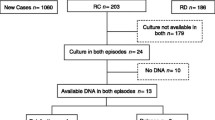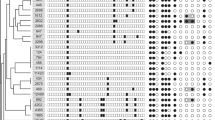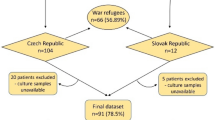Abstract
Purpose
Recurrence of tuberculosis (TB) can be the consequence of relapse or exogenous reinfection. The study aimed to assess the factors associated with exogenous TB reinfection.
Methods
Prospective cohort study based on the TB database, maintained at the Division of Infectious Diseases, Luigi Sacco Hospital (Milan, Italy). Time period: 1995–2010. Inclusion criteria: (1) ≥2 episodes of culture-confirmed TB; (2) cure of the first episode of TB; (3) availability of one Mycobacterium tuberculosis isolate for each episode. Genotyping of the M. tuberculosis strains to differentiate relapse and exogenous reinfection. Logistic regression analysis was used to assess the influence of risk factors on exogenous reinfections.
Result
Of the 4682 patients with TB, 83 were included. Of these, exogenous reinfection was diagnosed in 19 (23 %). It was independently associated with absence of multidrug resistance at the first episode [0, 10 (0.01–0.95), p = 0.045] and with prolonged interval between the first TB episode and its recurrence [7.38 (1.92–28.32) p = 0.004]. However, TB relapses occurred until 4 years after the first episode. The risk associated with being foreign born, extrapulmonary site of TB, and HIV infection was not statistically significant. In the relapse and re-infection cohort, one-third of the patients showed a worsened drug resistance profile during the recurrent TB episode.
Conclusions
Exogenous TB reinfections have been documented in low endemic areas, such as Italy. A causal association with HIV infection could not be confirmed. Relapses and exogenous reinfections shared an augmented risk of multidrug resistance development, frequently requiring the use of second-line anti-TB regimens.
Similar content being viewed by others
References
Jasmer RM, Bozeman L, Schwartzman K, Cave MD, Saukkonen JJ, Metchock B, et al. Recurrent Tuberculosis in the United States and Canada. Am J Respir Crit Care Med. 2004;170:1360–6.
Picon PD, Bassanesi SL, Avancini Caramori ML, Targa Ferreira RL, Jarczewski CA, Rodrigues de Borba Vieira P. Risk factors for recurrence of tuberculosis. J Bra Pneumol 2007; 33:572–578.
Charalambous S, Grant AD, Moloi V, Warren R, Day JH, van Helden P, et al. Contribution of reinfection to recurrent tuberculosis in South African gold miners. Int J Tuberc Lung Dis. 2008;12:942–8.
Bang D, Andersen AB, Thomsen VO, Lillebaek T. Recurrent tuberculosis in Denmark: relapse vs re-infection. Int J Tuberc Lung Dis. 2010;14:447–53.
Luzze H, Johnson DF, Dickman K, Mayanja-Kizza H, Okwera A, Eisenach K, et al. Relapse more common than reinfection in recurrent tuberculosis 1-2 years post treatment in urban Uganda. Int J Tuberc Lung Dis. 2013;17:361–7.
Das S, Chan SL, Allen BW, Mitchison DA, Lowrie DB. Application of DNA fingerprinting with IS986 to sequential mycobacterial isolates obtained from pulmonary tuberculosis patients in Hong Kong before, during and after short-course chemotherapy. Tuberc Lung Dis. 1993;74:4751.
Mallory KF, Churchyard GJ, Kleinschmidt I, De Cock KM, Corbett EL. The impact of HIV infection on recurrence of tuberculosis in South African gold miners. Int J Tuberc Lung Dis. 2000;4:455–62.
Das S, Paramasivan CN, Lowrie DB, Prabhakar R, Narayanan PR. IS6110 restriction fragment length polymorphism typing of clinical isolates of Mycobacterium tuberculosis from patients with pulmonary tuberculosis in Madras, south India. Tuber Lung Dis. 1995;76:550–4.
van Rie A, Warren R, Richardson M, Victor TC, Gie RP, Enarson DA, et al. Exogenous reinfection as a cause of recurrent tuberculosis after curative treatment. N Engl J Med. 1999;341:1174–9.
Crampin AC, Mwaungulu JN, Mwaungulu FD, Mwafulirwa DT, Munthali K, Floyd S, et al. Recurrent TB: relapse or reinfection? The effect of HIV in a general population cohort in Malawi. AIDS. 2010;24:417–26.
Sonnenberg P, Murray J, Glynn JR, Shearer S, Kambashi B, Godfrey-Faussett P. HIV-1 and recurrence, relapse, and reinfection of tuberculosis after cure: a cohort study in South African mineworkers. Lancet. 2001;358:1687–93.
Bandera A, Gori A, Catozzi L, Degli Esposti A, Marchetti G, Molteni C, et al. Molecular epidemiology study of exogenous reinfection in an area with a low incidence of tuberculosis. J Clin Microbiol. 2001;39:2213–8.
Garcia de Viedma DG, Marin M, Hernangomez S, Diaz M, Serrano MJ, Alcala L, et al. Tuberculosis recurrences: reinfection plays a role in a population whose clinical/epidemiological characteristics do not favor reinfection. Arch Intern Med. 2002;162:1873–9.
Fitzpatrick LK, Okwera A, Mugerwa R, Ridzon R, Ehiner J, Onorato I. An investigation of suspected exogenous reinfection in tuberculosis patients in Kampala, Uganda. Int J Tuberc Lung Dis. 2002;6:550–2.
Lambert ML, Hasker E, Van Duen A, Roberfroid D, Boelaert M, Van der Stuyft P. Recurrence in tuberculosis: relapse or reinfection. Lancet Infect Dis. 2003;3:282–7.
Chiang CY, Riley LW. Exogenous reinfection in tuberculosis. Lancet Infect Dis. 2005;5:629–36.
Wang JY, Lee LN, Lai HC, Hsu HL, Liaw YS, Hsueh PR, et al. Prediction of the tuberculosis reinfection proportion from the local incidence. J Infect Dis. 2007;196:281–8.
Franzetti F, Gori A, Iemoli E, Meraviglia P, Mainini F, Quirino T, et al. Outcome of multidrug-resistant tuberculosis in human immunodeficiency virus-infected patients. Clin Infect Dis. 1999;29:553–60.
Moro ML, Gori A, Errante I, Infuso A, Franzetti F, Sodano L, et al. An outbreak of multidrug-resistant tuberculosis involving HIV-infected patients of two hospitals in Milan, Italy. AIDS. 1998;12:1095–102.
Codecasa LR, Porretta AD, Gori A, Franzetti F, Degli Esposti A, Lizioli A, et al. Tuberculosis among immigrants from developing countries in the province of Milan, 1993–1996. Int J Tuberc Lung Dis. 1999;3:589–95.
CCM, ISS e Regione Emilia-Romagna. La tubercolosi in Italia. Rapporto 2008. http://www.salute.gov.it/imgs/c_17_pubblicazioni_1472_allegato.pdf.
Istituto Superiore di Sanità. Notiziario ISS. 2014;27(9):16–22.
Kamerbeek J, Schouls L, Kolk A, van Agterveld M, van Soolingen D, Kuijper S, et al. Simultaneous detection and strain differentiation of Mycobacterium tuberculosis for diagnosis and epidemiology. J Clin Microbiol. 1997;35:907–14.
Supply P, Lesjean S, Savine E, Kremer K, Van Soolingen D, Locht C. Automated high-throughput genotyping for study of global epidemiology of Mycobacterium tuberculosis based on mycobacterial interspersed repetitive units. J Clin Microbiol. 2001;39:3536–71.
World Health Organization; International union Against Tuberculosis and Lung Disease and Royal Netherlands Tuberculosis Association. Revised international definitions in tuberculosis control. Int J Tuberc Lung Dis. 2001;5:213–5.
Fine PEM, Small PM. Exogenous reinfection in tuberculosis. N Engl J Med. 1999;341:1226–7.
Sudre P, Pfyffer GE, Bodmer T, Prod’hom G, Furrer H, Bassetti S, et al. Molecular epidemiology of tuberculosis among HIV-infected persons in Switzerland: a countrywide 9-year cohort study: swiss HIV Cohort Study. Infection. 1999;27:323–30.
El Sahly HM, Wright JA, Soini H, Bui TT, Williams-Bouyer N, Escalante P, et al. Recurrent tuberculosis in Houston, Texas: a population-based study. Int J Tuberc Lung Dis. 2004;8:333–40.
Sahadevan R, Narayanan S, Paramasivan CN, Prabhakar R, Narayanan PR. Restriction fragment length polymorphism typing of clinical isolates of Mycobacterium tuberculosis from patients with pulmonary tuberculosis in Madras, India, by use of direct-repeat probe. J Clin Microbiol. 1995;33:3037–9.
Murray J, Sonnenberg P, Shearer SC, Godfrey-Faussett P. Human immunodeficiency virus and the outcome of treatment for new and recurrent pulmonary tuberculosis in African patients. Am J Respir Crit Care Med. 1999;159:733–40.
Caminero JA, Pena MJ, Campos-Herrero MI, Rodríguez JC, Afonso O, Martin C, et al. Exogenous reinfection with tuberculosis on a European island with a moderate incidence of disease. Am J Respir Crit Care Med. 2001;163:717–20.
Martín A, Herranz M, Navarro Y, Lasarte S, Ruiz Serrano MJ, Bouza E, et al. Evaluation of the inaccurate assignment of mixed infections by Mycobacterium tuberculosis as exogenous reinfection and analysis of the potential role of bacterial factors in reinfection. J Clin Microbiol. 2011;49:1331–8.
Houben RM, Crampin AC, Ndhlovu R, Sonnenberg P, Godfrey-Faussett P, Haas WH, et al. Human immunodeficiency virus associated tuberculosis more often due to recent infection than reactivation of latent infection. Int J Tuberc Lung Dis. 2011;15:24–31.
Glynn JR, Murray J, Bester A, Nelson G, Shearer S, Sonnenberg P. High rates of recurrence in HIV-infected and HIV-uninfected patients with tuberculosis. J Infect Dis. 2010;201:704–11.
Laserson KF, Thorpe LE, Leimane V, Weyer K, Mitnick CD, Riekstina V, Zarovska E, Rich ML, Fraser HS, Alarcón E, Cegielski JP, Grzemska M, Gupta R, Espinal M. Speaking the same language: treatment outcome definitions for multidrug-resistant tuberculosis. Int J Tuberc Lung Dis. 2005;9:640–5.
Acknowledgments
We owe a debt to Anna Pavan, formerly responsible for the Unit for Prevention, Hygiene and Infectious Diseases of the Health’s General Office, Lombardy region for access to TB regional database. All authors have seen and approved the manuscript and contributed significantly to the work. The manuscript has not been previously published or considered for publication elsewhere.
Conflict of interest
The authors declare that they have no conflict of interest.
Author information
Authors and Affiliations
Corresponding author
Rights and permissions
About this article
Cite this article
Schiroli, C., Carugati, M., Zanini, F. et al. Exogenous reinfection of tuberculosis in a low-burden area. Infection 43, 647–653 (2015). https://doi.org/10.1007/s15010-015-0759-9
Received:
Accepted:
Published:
Issue Date:
DOI: https://doi.org/10.1007/s15010-015-0759-9




